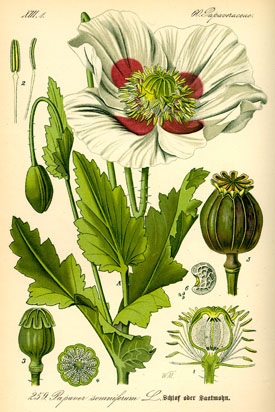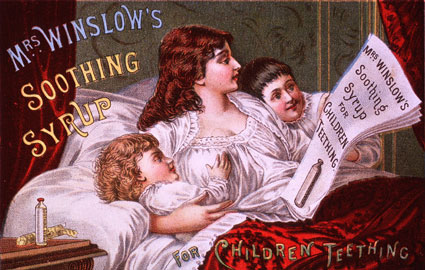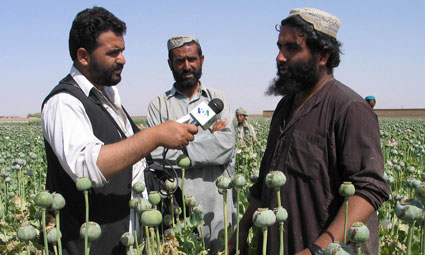Opium is extracted from the juice of poppies, and it contains a complex mixture of chemicals that are related to morphine, named for Morpheus, the Greek god of dreams. It has been used medicinally and socially for thousands of years to produce euphoria, analgesia, and sleep, and to prevent diarrhea.
Papaver somnifera

Source: Wikimedia Commons.
The poppy plant Papaver somniferum and its effects were known to the Persian, Egyptian, and Mesopotamian cultures. Poppy plants were first mentioned in Sumerian writing around 4000 B.C., where they were referred to as “plants of joy.” A significant advance in opium processing occurred in the sixteenth century when it was discovered that the alkaloids found in opium are significantly more soluble in alcohol than in water. Paracelsus (1490–1541) produced “laudanum” by extracting opium into brandy, creating a tincture of morphine.
By the nineteenth century, vials of laudanum and raw opium were freely available in English pharmacies and grocery stores. In eighteenth- and nineteenth-century Britain, opium was taken orally as a tincture of laudanum, and addiction to it was a sign of social status. British opium imports more than tripled from 45 tons in 1830 to 140 tons by 1860, and despite extensive British control of Indian production, imports of Turkish opium proved to have greater morphine content (A Brief History of Opium, 1999).
Opium was also well known in ancient China, where people ate parts of the flower or drank liquid extracts. By the seventh century, Turkish and Islamic cultures of western Asia discovered that the smoking of opium was more powerful. Widespread use of opium in China escalated after pipes for smoking were delivered by Dutch traders in the 1600s. Indians usually ate opium, whereas the Chinese smoked it, with and without tobacco. By the late 1700s, the British East India Company controlled the prime Indian poppy-growing areas and dominated the Asian opium trade and, though demand already existed, they had a created a monopoly and could control both supply and prices.
Opium was already a heavily used recreational drug in China; seeing this as detrimental to the people, the Imperial court banned its importation and use—but smuggling continued. In 1839 the Qing Emperor ordered his ministers to act, initiating the First Opium War with the British. The Chinese were defeated and forced to sign the Treaty of Nanjing in 1842, whereby the British opium trade was to continue, and the Chinese had to pay a large settlement, open five new ports to foreign trade, and cede Hong Kong to Britain.
After 14 years, the Second Opium War started over Western demands to increase the opium trade. China was defeated again by 1860 and opium importation to China was formally legalized, leading to even greater use. By 1900 an estimated 25% of adult male Chinese were addicted (A Brief History, 1999).
* * *
Morphine was first isolated from opium in 1805 by a German pharmacist. Doctors had searched for alternatives to oral administration of drugs, and opium in particular caused unpleasant gastric problems. With the invention of the hypodermic syringe in the mid-nineteenth century, injection of purified morphine was even more potent and rapid acting than opium itself. Morphine addiction became widespread in the United States following its extensive use by maimed soldiers on both sides of the Civil War. Opiates were cheap, legal and prevalent in the United States of the late 1800s. It was mistakenly believed that injecting morphine was not addictive, whereas ending habitual opium use caused flu-like symptoms and depression that morphine could easily alleviate.

From a calendar of 1886. Source: U.S. National Library of Medicine, NIH.
A powerful non-addictive alternative to opium and morphine would be ideal. In 1874 an English pharmacist boiled morphine and acetic acid (vinegar), acetylating both of the hydroxyl groups on morphine, to produce diacetylmorphine. This was synthesized and marketed commercially by the German pharmaceutical giant, Bayer, in 1898. Bayer launched the best-selling drug brand of all time, Heroin, as “the sedative for coughs.” The new drug enjoyed widespread acceptance in the medical community and among patients.
Bayer was actively selling Heroin to dozens of countries, with free samples given to physicians. It was several years before the risk of addiction became obvious to doctors, who noted the extraordinary use of Heroin-based cough medicine. Heroin was not the miracle cure for morphine or opium addiction that some had hoped, so in 1913 Bayer halted production and erased the drug from their official company history. Bayer then focused on marketing their second blockbuster drug, aspirin.
Eventually in 1910, after 150 years of failed attempts to rid the country of opium, the Chinese were successful in convincing the British to dismantle the India–China opium trade. By the 1920s, many Western countries had made opiate use illegal, unless by prescription with medical care. As recently as 2007, Afghanistan’s poppy production rose an estimated 15% over that in 2006 (Washington Post, 2007). The U.S. State Department’s top counter-narcotics official, Tom Schweich, claims that Afghanistan is now “providing close to 95% of the world’s heroin.”

Voice of America reporter interviewing Afghan poppy cultivators. Source: Wikimedia Commons.
